2015 NISSAN GT-R seat adjustment
[x] Cancel search: seat adjustmentPage 6 of 358
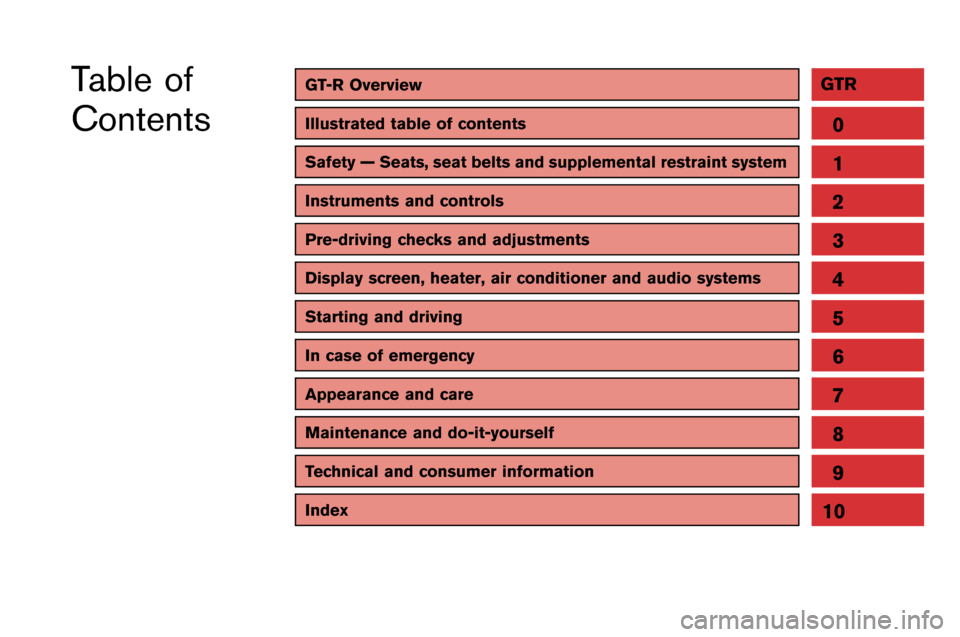
GT-R OverviewGTR
Illustrated table of contents0
Safety — Seats, seat belts and supplemental restraint system
Instruments and controls
Pre-driving checks and adjustments
Display screen, heater, air conditioner and audio systems
Starting and driving
In case of emergency
Appearance and care
Maintenance and do-it-yourself
Technical and consumer information
1
2
3
4
5
6
7
8
9
Table of
Contents
Index10
GT-R OverviewGTR
Illustrated table of contents0
Safety — Seats, seat belts and supplemental restraint system
Instruments and controls
Pre-driving checks and adjustments
Display screen, heater, air conditioner and audio systems
Starting and driving
In case of emergency
Appearance and care
Maintenance and do-it-yourself
Technical and consumer information1
2
3
4
5
6
7
8
9
Table of
Contents
Index10
Page 51 of 358
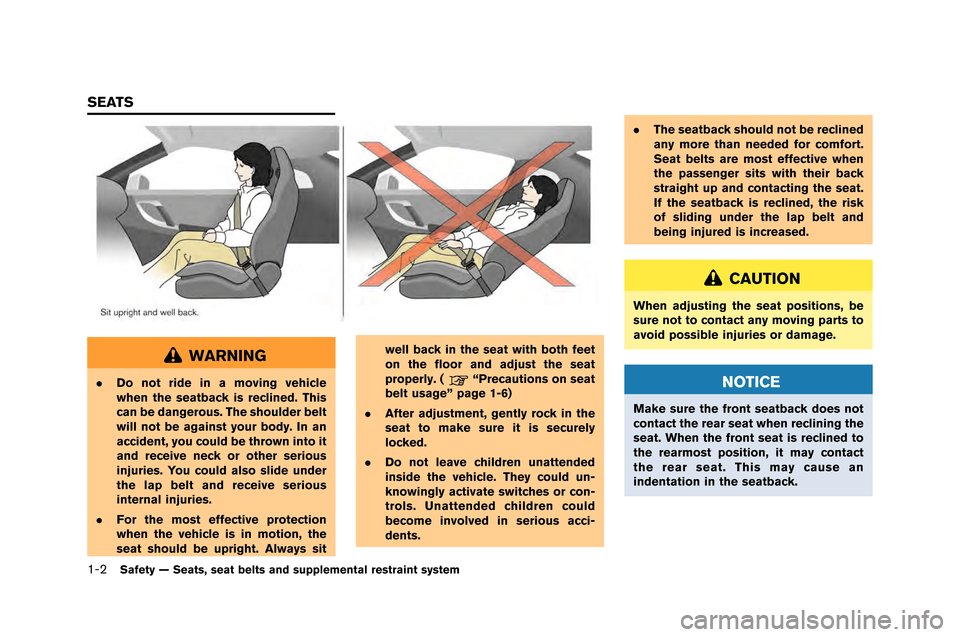
1-2Safety — Seats, seat belts and supplemental restraint system
WARNING
.Do not ride in a moving vehicle
when the seatback is reclined. This
can be dangerous. The shoulder belt
will not be against your body. In an
accident, you could be thrown into it
and receive neck or other serious
injuries. You could also slide under
the lap belt and receive serious
internal injuries.
. For the most effective protection
when the vehicle is in motion, the
seat should be upright. Always sit well back in the seat with both feet
on the floor and adjust the seat
properly. (“Precautions on seat
belt usage” page 1-6)
. After adjustment, gently rock in the
seat to make sure it is securely
locked.
. Do not leave children unattended
inside the vehicle. They could un-
knowingly activate switches or con-
trols. Unattended children could
become involved in serious acci-
dents. .
The seatback should not be reclined
any more than needed for comfort.
Seat belts are most effective when
the passenger sits with their back
straight up and contacting the seat.
If the seatback is reclined, the risk
of sliding under the lap belt and
being injured is increased.
CAUTION
When adjusting the seat positions, be
sure not to contact any moving parts to
avoid possible injuries or damage.
NOTICE
Make sure the front seatback does not
contact the rear seat when reclining the
seat. When the front seat is reclined to
the rearmost position, it may contact
the rear seat. This may cause an
indentation in the seatback.
SEATS
Page 52 of 358
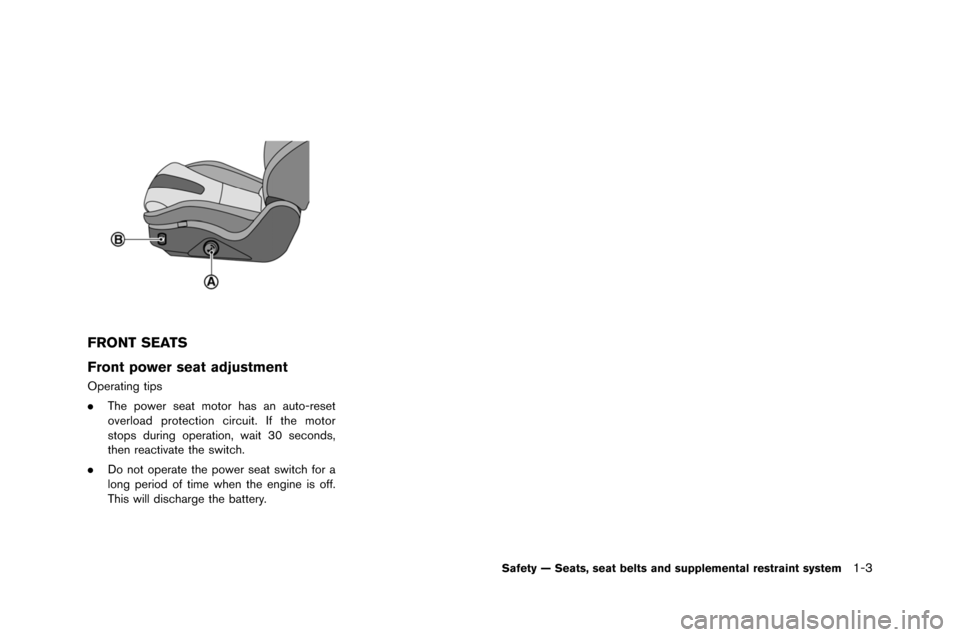
FRONT SEATS
Front power seat adjustment
Operating tips
.The power seat motor has an auto-reset
overloa\f protection circuit. I\b the motor
stops \furing operation, wait 30 secon\fs,
then reactivate the switch.
. Do not operate the power seat switch \bor a
long perio\f o\b time when the engine is o\b\b.
This will \fischarge the battery.
Safety — Seats, seat belts and supplemental restraint system1-3
Page 53 of 358
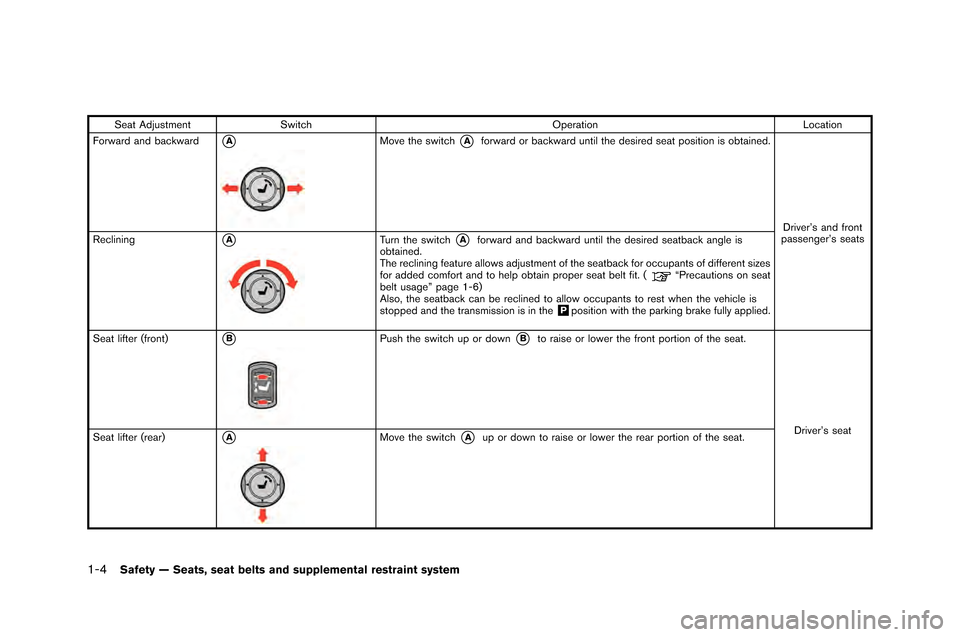
1-4Safety — Seats, seat belts and supplemental restraint system
Seat AdjustmentSwitch O�ferationLocation
�borward and backward
*AMove the switch*Aforward or backward until the desired seat �fosition is obtained.
Driver’s and front
�fassenger’s seats
Reclining
*ATurn the switch*Aforward and backward until the desired seatback angle is
obtained.
The reclining feature allows adjustment of the seatback for occu�fants of different sizes
for added comfort and to hel�f obtain �fro�fer seat belt fit. (
“Precautions on seat
belt usage” �fage 1-6)
Also, the seatback can be reclined to allow occu�fants to rest when the vehicle is
sto�f�fed and the transmission is in the
&P�fosition with the �farking brake fully a�f�flied.
Seat lifter (front)
*BPush the switch u�f or down*Bto raise or lower the front �fortion of the seat.
Driver’s seat
Seat lifter (rear)
*AMove the switch*Au�f or down to raise or lower the rear �fortion of the seat.
Page 54 of 358
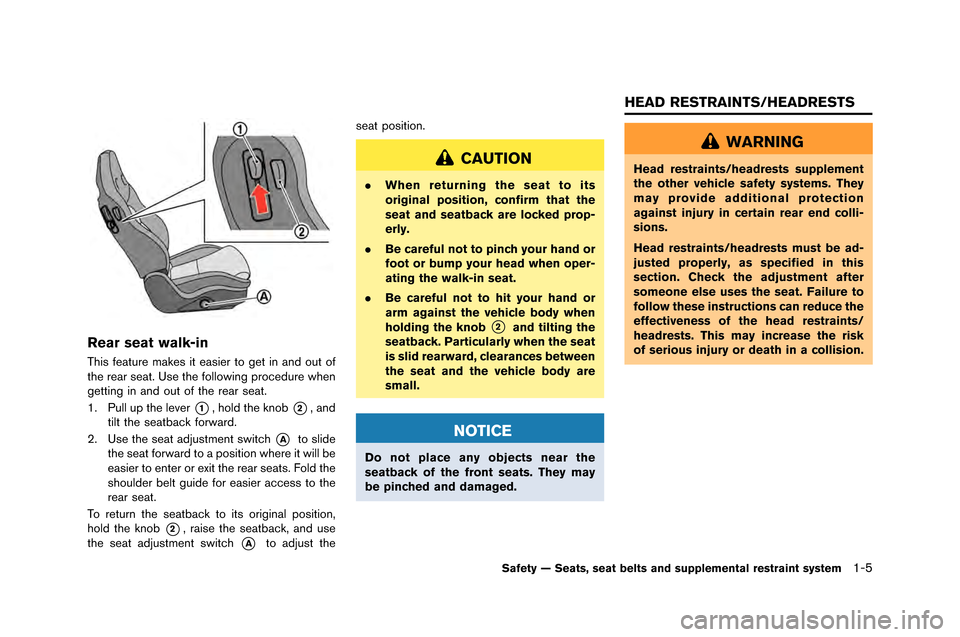
Rear seat walk-in
This feature makes it easier to get in and out of
the rear seat. Use the follo\fing procedure \fhen
getting in and out of the rear seat.
1. \bull up the lever
*1, hold the knob*2, and
tilt the seatback for\fard.
2. Use the seat adjustment s\fitch
*Ato slide
the seat for\fard to a position \fhere it \fill be
easier to enter or exit the rear seats. Fold the
shoulder belt guide for easier access to the
rear seat.
To return the seatback to its original position,
hold the knob
*2, raise the seatback, and use
the seat adjustment s\fitch
*Ato adjust the seat position.
CAUTION
.
When returning the seat to its
original position, confirm that the
seat and seatback are locked prop-
erly.
. Be careful not to pinch your hand or
foot or bump your head when oper-
ating the walk-in seat.
. Be careful not to hit your hand or
arm against the vehicle body when
holding the knob
*2and tilting the
seatback. Particularly when the seat
is slid rearward, clearances between
the seat and the vehicle body are
small.
NOTICE
Do not place any objects near the
seatback of the front seats. They may
be pinched and damaged.
WARNING
Head restraints/headrests supplement
the other vehicle safety systems. They
may provide additional protection
against injury in certain rear end colli-
sions.
Head restraints/headrests must be ad-
justed properly, as specified in this
section. Check the adjustment after
someone else uses the seat. Failure to
follow these instructions can reduce the
effectiveness of the head restraints/
headrests. This may increase the risk
of serious injury or death in a collision.
Safety — Seats, seat belts and supplemental restraint system1-5
HEAD RESTRAINTS/HEADRESTS
Page 65 of 358
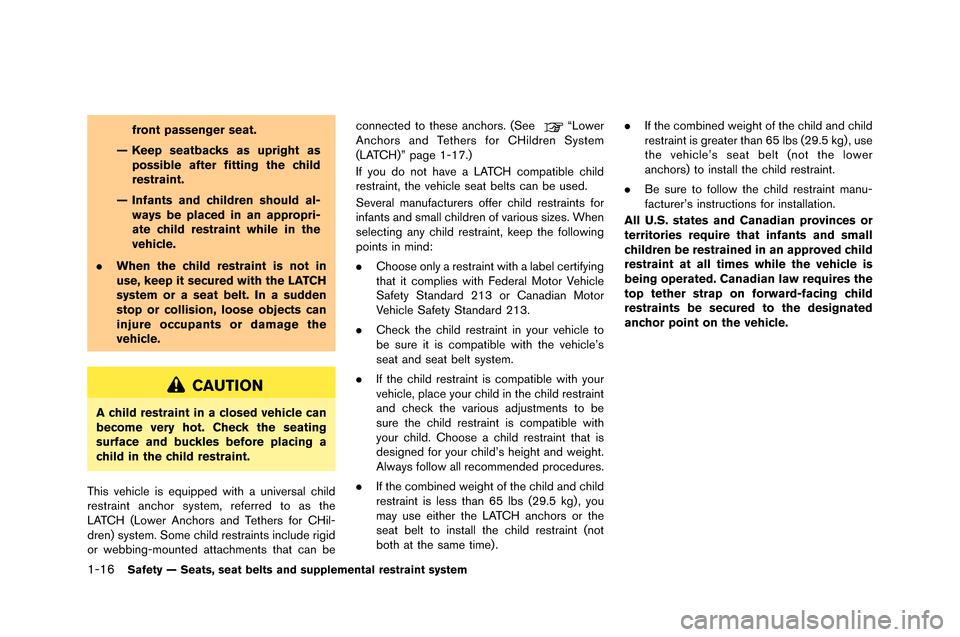
1-16Safety — Seats, seat belts and supplemental restraint system
front passenger seat.
— Keep seatbacks as upright as possible after fitting the child
restraint.
— Infants and children should al- ways be placed in an appropri-
ate child restraint while in the
vehicle.
. When the child restraint is not in
use, keep it secured with the LATCH
system or a seat belt. In a sudden
stop or collision, loose objects can
injure occupants or damage the
vehicle.
CAUTION
A child restraint in a closed vehicle can
become very hot. Check the seating
surface and buckles before placing a
child in the child restraint.
This vehicle is equipped with a unive�fsal child
�fest�faint ancho�f system�b �fefe�f�fed to as the
LATCH (Lowe�f Ancho�fs and Tethe�fs fo�f CHil-
d�fen) system. Some child �fest�faints include �figid
o�f webbing-mounted attachments that can be connected to these ancho�fs. (See
“Lowe�f
Ancho�fs and Tethe�fs fo�f CHild�fen System
(LATCH)” page 1-17.)
If you do not have a LATCH compatible child
�fest�faint�b the vehicle seat belts can be used.
Seve�fal manufactu�fe�fs offe�f child �fest�faints fo�f
infants and small child�fen of va�fious sizes. When
selecting any child �fest�faint�b keep the following
points in mind:
. Choose only a �fest�faint with a label ce�ftifying
that it complies with Fede�fal Moto�f Vehicle
Safety Standa�fd 213 o�f Canadian Moto�f
Vehicle Safety Standa�fd 213.
. Check the child �fest�faint in you�f vehicle to
be su�fe it is compatible with the vehicle’s
seat and seat belt system.
. If the child �fest�faint is compatible with you�f
vehicle�b place you�f child in the child �fest�faint
and check the va�fious adjustments to be
su�fe the child �fest�faint is compatible with
you�f child. Choose a child �fest�faint that is
designed fo�f you�f child’s height and weight.
Always follow all �fecommended p�focedu�fes.
. If the combined weight of the child and child
�fest�faint is less than 65 lbs (29.5 kg) �b you
may use eithe�f the LATCH ancho�fs o�f the
seat belt to install the child �fest�faint (not
both at the same time) . .
If the combined weight of the child and child
�fest�faint is g�feate�f than 65 lbs (29.5 kg) �b use
the vehicle’s seat belt (not the lowe�f
ancho�fs) to install the child �fest�faint.
. Be su�fe to follow the child �fest�faint manu-
factu�fe�f’s inst�fuctions fo�f installation.
All U.S. states and Canadian provinces or
territories require that infants and small
children be restrained in an approved child
restraint at all times while the vehicle is
being operated. Canadian law requires the
top tether strap on forward-facing child
restraints be secured to the designated
anchor point on the vehicle.
Page 80 of 358
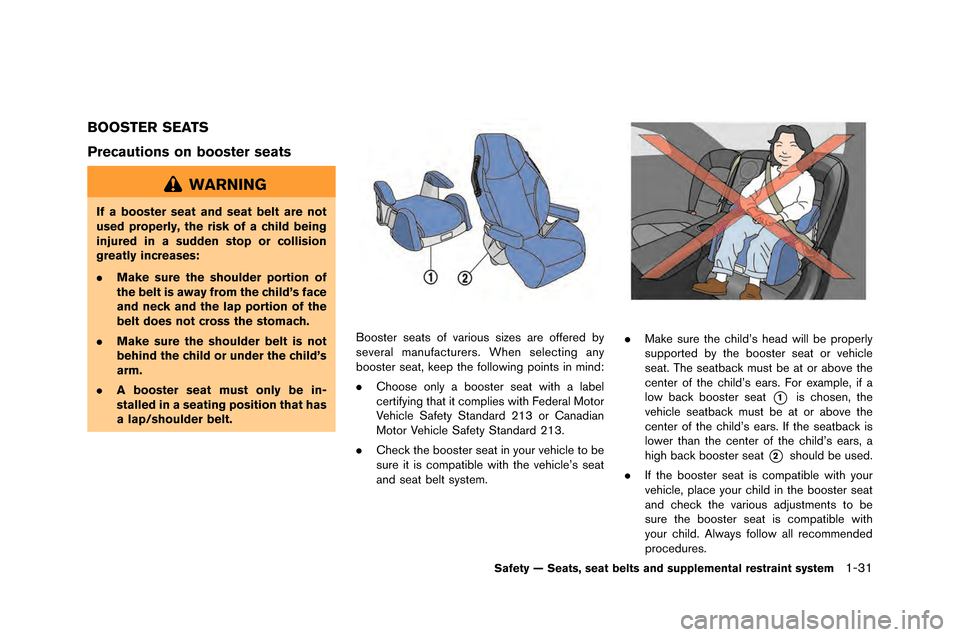
BOOSTER SEATS
Precautions on booster seats
WARNING
If a booster seat and seat belt are not
used properly, the risk of a child being
injured in a sudden stop or collision
greatly increases:
.Make sure the shoulder portion of
the belt is away from the child’s face
and neck and the lap portion of the
belt does not cross the stomach.
. Make sure the shoulder belt is not
behind the child or under the child’s
arm.
. A booster seat must only be in-
stalled in a seating position that has
a lap/shoulder belt.
Booster seats of various sizes are offered by
several manufacturers�f When selecting any
booster seat�b keep the following points in mind:
.Choose only a booster seat with a label
certifying that it complies with Federal Motor
Vehicle Safety Standard 213 or Canadian
Motor Vehicle Safety Standard 213�f
. Check the booster seat in your vehicle to be
sure it is compatible with the vehicle’s seat
and seat belt system�f.Make sure the child’s head will be properly
supported by the booster seat or vehicle
seat�f The seatback must be at or above the
center of the child’s ears�f For example�b if a
low back booster seat
*1is chosen�b the
vehicle seatback must be at or above the
center of the child’s ears�f If the seatback is
lower than the center of the child’s ears�b a
high back booster seat
*2should be used�f
. If the booster seat is compatible with your
vehicle�b place your child in the booster seat
and check the various adjustments to be
sure the booster seat is compatible with
your child�f Always follow all recommended
procedures�f
Safety — Seats, seat belts and supplemental restraint system1-31
Page 169 of 358
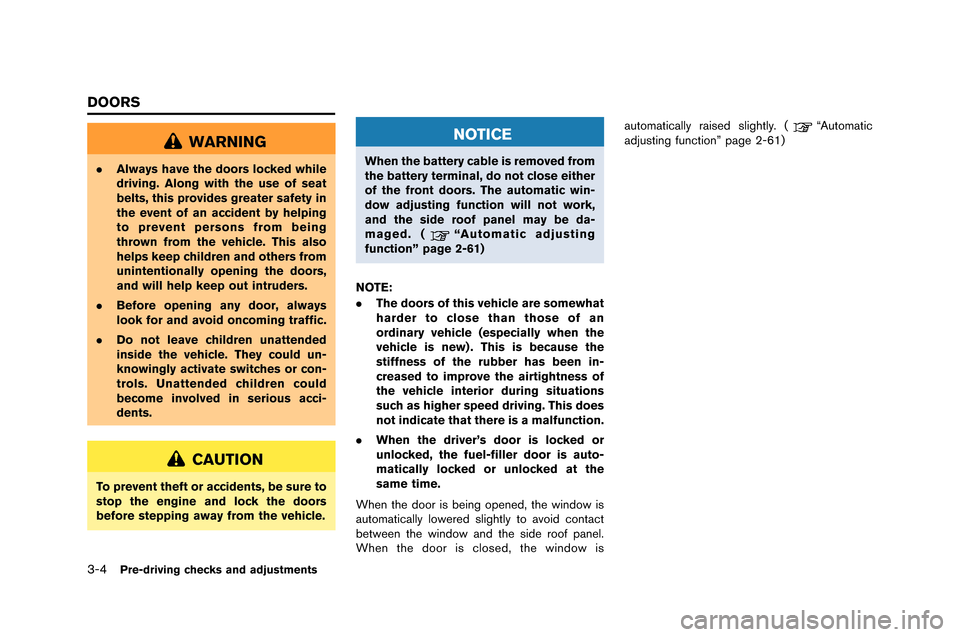
3-4Pre-driving checks and adjustments
WARNING
.Always have the doors locked while
driving. Along with the use of seat
belts, this provides greater safety in
the event of an accident by helping
to prevent persons from being
thrown from the vehicle. This also
helps keep children and others from
unintentionally opening the doors,
and will help keep out intruders.
. Before opening any door, always
look for and avoid oncoming traffic.
. Do not leave children unattended
inside the vehicle. They could un-
knowingly activate switches or con-
trols. Unattended children could
become involved in serious acci-
dents.
CAUTION
To prevent theft or accidents, be sure to
stop the engine and lock the doors
before stepping away from the vehicle.
NOTICE
When the battery cable is removed from
the battery terminal, do not close either
of the front doors. The automatic win-
dow adjusting function will not work,
and the side roof panel may be da-
maged. (
“Automatic adjusting
function” page 2-61)
NOTE:
. The doors of this vehicle are somewhat
harder to close than those of an
ordinary vehicle (especially when the
vehicle is new) . This is because the
stiffness of the rubber has been in-
creased to improve the airtightness of
the vehicle interior during situations
such as higher speed driving. This does
not indicate that there is a malfunction.
. When the driver’s door is locked or
unlocked, the fuel-filler door is auto-
matically locked or unlocked at the
same time.
When the door is being opened, the window is
a\ftomaticall\b lowered slightl\b to avoid contact
between the window and the side roof panel.
When the door is closed, the window is a\ftomaticall\b raised slightl\b. (
“A\ftomatic
adj\fsting f\fnction” page 2-61)
DOORS